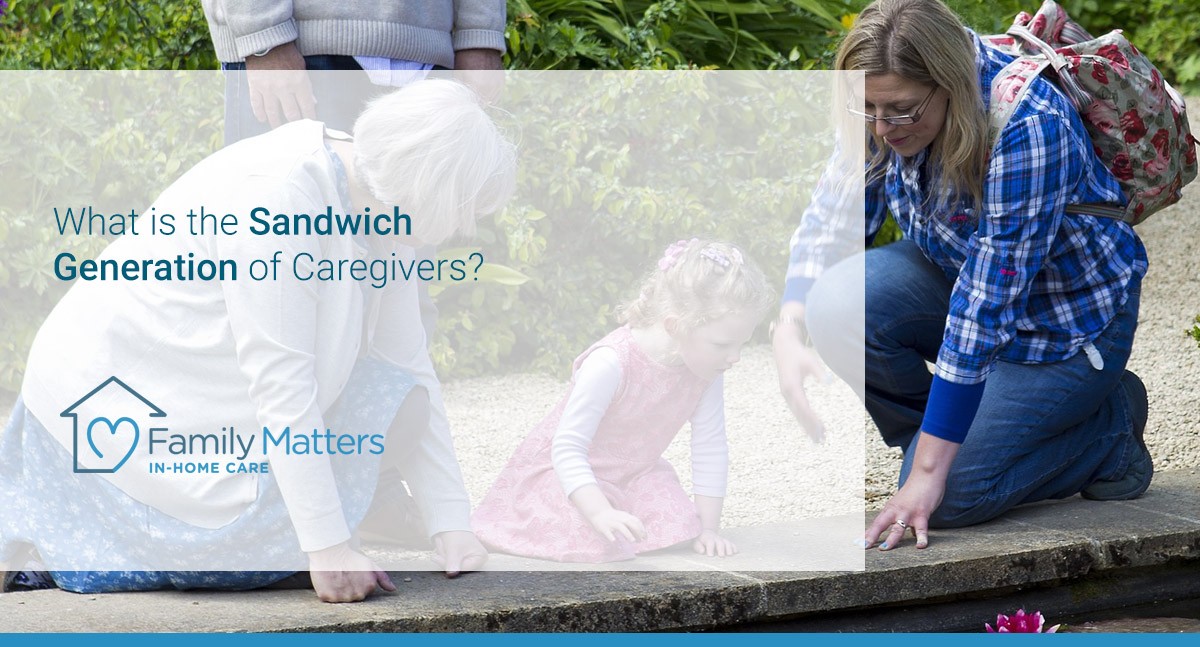
What is the Sandwich Generation of Caregivers?
At first glance, “sandwich generation” sounds like a term apropos to “latchkey kids”—yet another clever slogan describing a generation of people who were required to fend for themselves. Both terms inspire this image of children returning from school to an empty home (because both parents are at work), and then making their own sandwich for dinner before beginning chores or turning on the television.
Not quite.
What is the “Sandwich Generation”?
While the sandwich generation is related to family dynamics, and specifically to parents and children, it has nothing to do with an actual snack. Rather, the meaning of the phrase can best be understood in an article by Dorothy A. Miller about “adult children of the elderly, who are ‘sandwiched’ between their aging parents and their own maturing children.”
You may be surprised at how many people fit this profile.
Currently, according to the Pew Research Center, “about 1-in-7 middle-aged adults is providing financial support to both an aging parent and a child.” And this issue isn’t limited solely to those with younger children. This TD Ameritrade study, estimates that the percentage of young adults moving back home after college (the Boomerang Generation), now approaches 50%.
Essentially, two significant trends are transpiring simultaneously:
- Our parents are living longer.
- Our children are living with us longer.
As a result, a large group of people between their 40’s and 60’s is feeling the squeeze from both ends.
Miller’s study underscores a growing concern: People in the sandwich generation are under a significant amount of stress and in need of assistance from committed professionals.
A Problem of Imbalance
The most compelling fact that has been uncovered by researchers studying this phenomenon is also the most obvious one. People in the sandwich generation are doubling their care for others while receiving little in return.
Consider that a person attempting to concurrently look after both their children and parents must do so through several avenues. These include but are not limited to:
- Financial aid
- Emotional support
- Daily supervision (especially when the children are young, or the parents are elderly)
- Future stage-of-life planning (weddings, graduations, funerals, etc.)
Meanwhile, due to the inherent challenges that the older and younger generations face while conducting their own life’s journey, the sandwich generation rarely experiences reciprocity. Sometimes, neither of the two generations that they support is well-positioned to return the favor.
Multigenerational Households
While multigenerational living has been a common practice in many other cultures for a long time, it’s a comparatively newer concept in the U.S. that’s experiencing notable growth. The organization known as Generations United points out that between the years 2000-2016 multigenerational homes increased by 21.6 million and that, today, 1 in 5 American households can be defined as such.
There are two reasons offering our parents companion care in our homes has become more commonplace.
- High costs associated with private nursing homes
- Anxiety and stress associated with asking strangers to care for our parent(s)
In other words, when considering options, more people are wary or afraid of the alternatives.
Subsequently, studies show that the sandwich generation is just as happy as their contemporaries not “burdened” by multigenerational living because they see the merits in this arrangement. The prospects of forcing either one’s children or one’s parents to fend for themselves is more disconcerting than finding ways to manage the sandwich press in which this generation finds itself.
How to Proceed
This is where home care organizations can help.
Miller suggests that pursuing institutionalization as an option has the potential to become a traumatic experience, especially with some of the pervasive negative stories surrounding nursing homes. A possible alternative to ease the workload of someone in the sandwich generation is seeking outside services to help in the home. This is a less expensive option which can offer some peace of mind to all involved.
Specifically, two types of services should be considered if you find yourself an official member of the sandwich generation:
- Attend informational programs that will educate all family members about the latest findings related to what a healthy aging process looks like (including a refresher on common challenges the elderly may encounter such as sensory loss and diminishing strength and agility).
- Establish a plan for critical or chronic issues that might arise later.
Ultimately, a deepening appreciation for the challenges the sandwich generation faces does not mean someone must play the role of a hero to meet the demands. Plan well, communicate frequently, and seek advice (and help) from experts.
If you or your family member is considering in-home care as part of a plan to age in place, contact Family Matters In-Home Care today for a free consultation. Our team is dedicated to supporting your family and helping older adults enjoy life in the comfort of their own home for as long as possible.
Some of the services offered by Family Matter In-Home Care include: Alzheimer’s & Dementia Care, Bed & Wheelchair Transfer Assistance, Companionship, Housekeeping & Meal Preparation, Personal Care, Recovery Care, and Transportation.
Serving the San Francisco Bay Area and Greater San Diego, Family Matter In-Home Care has offices throughout California including: Campbell, CA, Roseville, CA, San Marcos, CA, and San Mateo, CA.
